The term Application Management can sometimes be too generic for many business users, so let’s first ensure we’re defining what we are talking about. Application Management Services refer to the ongoing management, maintenance, and support of software applications in...
Infrastructure
How to Deal with Single Points of Failure: Software (Updated 2023)
There are plenty of false economies that place your business at risk, For example, leaving system administration to engineers and the vulnerabilities tied to hardware failures. However, hardware isn't the sole point of failure. Software and the unpredictable human...
What is Observability And How Can It Optimize IT?
Your IT architecture is anything but simple. In fact, it’s more like the complex, yet silent spinal cord of your business functions. But what can you do when something goes wrong? Monitoring tools give you a partial view into business performance (or issues),...
Top 5 Challenges Of Infrastructure Management (Updated 2023)
Managing infrastructure comes with unique challenges. Lab network, computer farm, load-balancing app, build-and-release system - each is distinct. "IT" is a broad term, but it comprises separate realms that are easily overlooked. But, understanding the uniqueness of...
Using Jira Advanced Roadmaps for Program Management
. Here is the VLOG transcript for Carlos Almeida, Vice President of Engineering, SPK and Associates discussing Jira Advanced Roadmaps. For the best experience, we recommend watching the video so you can follow along with any instructions. Introduction Today we're...
Configuration Management: The Heart of Your Software Development Lifecycle (SDLC)
Does your software development organization have a well defined and implemented configuration management (CM) process? For many organizations, they equate the CM process with having a revision control tool in place. While versioning is a necessary prerequisite to...
2022 Technology Year in Review
In the past 3 years, our world has definitely changed. This year was no exception. From the early days of the COVID-19 pandemic to the great resignation, businesses have had to adapt to changing government regulations, employee needs, and methods of doing business. ...
Atlassian Team 22 Announcements – Part 2/2
Welcome back to Atlassian Team 22 Announcements This follow up blog deep dives into even more exciting Atlassian Team 22 updates announced in Las Vegas, April 2022. Read part 1, then explore part 2 below. Part 2 provides a deeper review on Atlassian’s DevOps...
The Power of the Cloud – Med Device Company Boosts Operational Efficiency and Customer Satisfaction
BackgroundA diversified medical device company has a leading position in the global endoscopy device space. In this market, the company generates growth and differentiates its products primarily through incremental innovations and investment in research and...
Improving Accessibility and Accuracy of Engineering Documents Via a Cloud-Based SolidWorks to MasterControl Connector
How SPK successfully improved a client’s engineering productivity and quality by creating a connected business system, leveraging separate, complementary platforms. Bridging TechnologiesMedical device manufacturing is a highly regulated industry. Even the slightest...
5 Best Practices That Could Have Protected You From Log4J
Log4j: What Is It? On December 9, 2021, a critical exploit named "Log4j" was disclosed to the world. This exploit was particularly harrowing due to the fact that the software library which it targeted is so widely utilized. “Log4Shell” (CVE-2021-44228,...
Streamline Business Communication with Google Forms
Have you ever sent out an email with a bunch of important questions and received a reply that began with "my answers are in blue". Have you then found yourself combing through your large email searching for those answers only to discover that your email provider...













